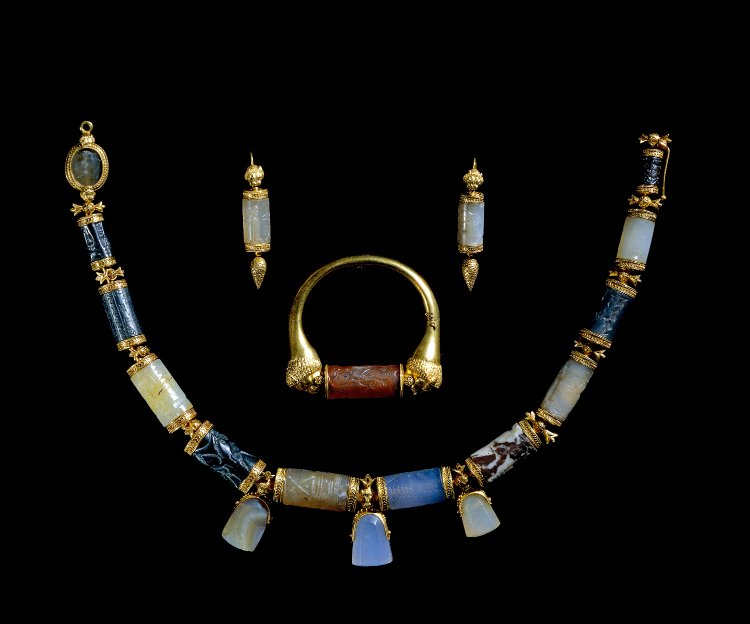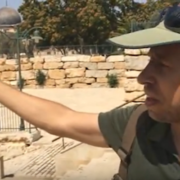Bejeweled
Warning: This is a post about jewelry. Be wary when sharing it on social media before the holidays.
On This Day

Hilda and Flinders Petrie 1903
Did you know that on this day (November 26th) in 1896 Sir Flinders Petrie married his wife Hilda, who excavated with him throughout their marriage? Perhaps best known for his excavations in Egypt, Sir Flinders Petrie also spent time excavating and doing research here in Israel. We would like to wish the Petries a happy 120th anniversary.
Research
Well, this is a great excuse to talk about some of our research here at the Sifting Project, and weddings always make me think of rings. Though we have many rings of different styles and types, today we are going to focus on glass rings and bracelets.
During the first nine years of the Sifting Project approximately 1800 glass bracelet fragments and about 150 glass finger ring fragments were recovered and catalogued (we have since found many more but they are waiting to be officially counted and added to the database.) Circular glass “bangle” bracelets were common in Israel from late Roman times to the present, and these inexpensive bracelets were the most prevalent type of glass jewelry in the Levant and the Near East. Although the majority of these bracelet fragments are the brightly colored ones popular during the Islamic periods, especially Mamluk and Ottoman, the collection includes some that are consistent with the dark monochrome bracelets dated to the Late Roman and Early Byzantine periods. The range of bracelet diameters indicates that these inexpensive ornaments were popular among children as well as adults. Glass finger rings, some matching the glass bracelet styles (such as the bracelet third from the right), were not as varied or as popular as the bracelets.

Assorted Glass Bracelet Fragments Found by the Sifting Project
Glass Bracelets
Glass bracelets first appeared in Egypt in the 2nd millennium B.C.E. They became more popular in Europe during the last centuries of the first millennium BCE, but did not become common in the Levant until the 3rd century C.E. They were very popular during the Islamic periods when brightly colored bracelets replaced the earlier mostly dark-colored ones. During the later Islamic periods Tyrus, Hebron, Aleppo, Acre, Sidon, Raqqa, Cairo, Alexandria and Damascus were famous glass production centers, and Hebron was especially famous for its glass bracelets from the 16th through the 19th centuries. Bracelets from Hebron were still made there and sold in Jerusalem into the 20th century.

Assorted Glass Ring Fragments Found by the Sifting Project
Glass Finger Rings
Glass rings began to appear in Israel in the late Roman period, about the same time as glass bracelets. Their types were not as varied as the bracelets, nor were they as popular, but the sizes indicate that many were worn by children. The rings are often monochrome, but the rings of the Islamic era are multicolored, with added colored patches and trails creating rings that matched bracelet types. One popular type found on the Temple Mount was a simple monochrome band decorated with an added contrasting glass “gem” at the seam. Another was monochrome with a flattened rhomboidal or oval bezel. Glass rings were produced in Hebron during most periods and continuing into the 19th century.
Very few glass rings have been published from sites in Israel, and Maud Spaer (see below) only wrote a typology for glass bracelets, not glass rings. Consequently, the dating of many of our rings is based on finding matching types of bracelets, and giving the rings the same date as the bracelets. For example, the ring on the far right matches the bracelet 3rd from the right — turquoise base with white-yellow-orange-black-striped patches.
Further Reading
Maud Spaer, “The Pre-Islamic Glass Bracelets of Palestine,” Journal of Glass Studies, Vol. 30 (1988), pp. 51‒61; “The Islamic Glass Bracelets of Palestine: Preliminary Findings,” JGS, Vol. 34 (1992), pp. 44‒62.
Margreet L. Steiner, “An Analysis of the Islamic Glass Bracelets Found at Tell Abu Sarbut,” in M. Steiner and E. van der Steen, Sacred and Sweet: Studies in the Material Culture of Tell Deir ’Alla and Tell Abu Sarbut (Leuven: Peeters, 2008), pp. 231-239.
Maud Spaer, “Bracelets and Other Jewelry,” Ancient Glass in the Israel Museum: Beads and Other Small Objects (Jerusalem: The Israel Museum, 2001), pp. 193‒210, Pls. 33‒37.
 Can I write a post script on a blog? Now I know that this has nothing to do with our project or the Petries, but speaking about archaeology and weddings, how amazing is this jewelry made out of cylinder seals? It was given by Archaeologist Henry Layard as a wedding gift to his wife Enid in 1869. It is currently in the British Museum. Now you all know what to get me for the holidays.
Can I write a post script on a blog? Now I know that this has nothing to do with our project or the Petries, but speaking about archaeology and weddings, how amazing is this jewelry made out of cylinder seals? It was given by Archaeologist Henry Layard as a wedding gift to his wife Enid in 1869. It is currently in the British Museum. Now you all know what to get me for the holidays.












Reblogged this on Kattukse Vrienden voor Israël.